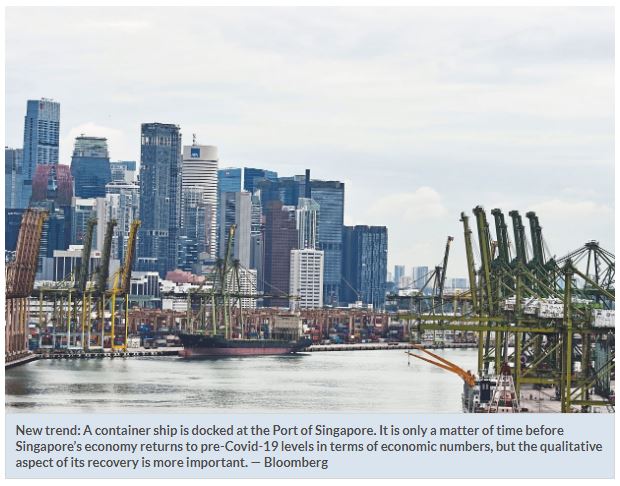Four factors to determine Singapore’s pace of recovery
SINGAPORE: While Singapore is turning the corner in its economic recovery, it still has a long way to go as it adapts to the new realities of the Covid-19 world, said Trade and Industry Minister Chan Chun Sing yesterday.
The improvement in Singapore’s economy in the third quarter of 2020 shows that the Republic is on the right path, he said.
Singapore’s economy beat estimates as it shrunk 5.8% year-on-year in the third quarter, better than the 13.3% decline seen in the previous quarter, which was also Singapore’s worst quarterly performance on record.
Speaking at a media briefing, Chan outlined four factors which will impact the pace of economic recovery domestically and globally – two of which are within Singapore’s control.
The country’s coronavirus infection rates and the ability of its businesses and workers to pivot and adapt to the Covid-19 world are within its control, he noted.
“If we are able to continue to keep our infection rates low, we will be able to resume more activities and increase our interactions with the rest of the world.
“This will require the continued cooperation of our people to adhere to the prevailing measures, ” Chan said.
But global developments – the geopolitical dynamics between big countries such as US and China, and the recurring waves of infection happening globally – are outside Singapore’s control, he noted.
“We do not yet know how the new US administration will approach its relations with China.
“But we hope both sides will dial down tensions and return to a more open and inclusive global economic order, ” Chan said, adding that the path forward lies in greater interdependence rather than independence.
Meanwhile, recurring waves of infection abroad, leading to new and more frequent lockdowns, will also have a knock-on effect on global demand which will affect export-oriented economies like Singapore, he said.
“So long as we manage the controllable factors well, and mitigate the risks of those beyond our control, I believe we can recover more quickly, ” Chan said.
Singapore now has the testing capabilities, isolation facilities and healthcare capacity to manage risks from imported cases, to ensure they do not infect the local community, which will allow Singapore to open its borders more, he said.
This would allow more Singapore-based residents and workers to travel overseas for work, and for the necessary professionals and workers who drive the Republic’s economy and support its social services to come in.
In addition, Singapore will also be able to progressively host more significant meetings, incentives, conferences and exhibitions (MICE) events to maintain its position as a leading business node, Chan highlighted, adding that he will share more on this at the TravelRevive trade show on Wednesday.
“The number of imported cases may rise, but the risk to the local community will be mitigated, ” he said.
Chan said it was only a matter of time before Singapore’s economy returns to pre-Covid-19 levels in terms of economic numbers, but the qualitative aspect of its recovery is more important, given how the economy would have changed permanently, such as in supply chain patterns and the surge in digitalisation and technological advancements.
Singapore’s economic measures must keep pace with the demands of the market, which is why it is imperative to help businesses and workers move towards new areas, he added.
The government’s support measures towards businesses and workers will also pivot, he said, noting that it is “not possible” for the government to indefinitely support business models that are no longer relevant and competitive in a Covid-19 world.
“Going forward, our support must be more targeted and focus on positive outcomes for our businesses and workers, ” he said, adding that the authorities will help businesses strengthen existing capabilities and build new ones. — The Straits Times/ANN


 Thailand
Thailand




